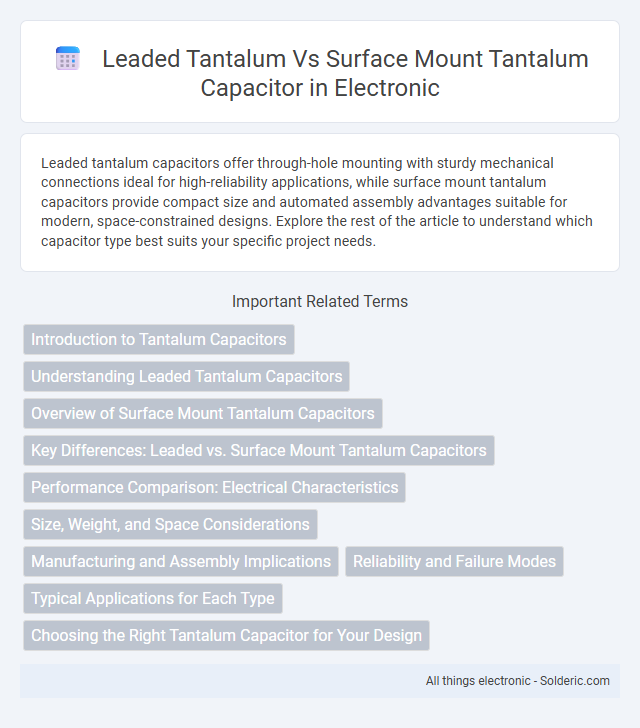Leaded tantalum capacitors offer through-hole mounting with sturdy mechanical connections ideal for high-reliability applications, while surface mount tantalum capacitors provide compact size and automated assembly advantages suitable for modern, space-constrained designs. Explore the rest of the article to understand which capacitor type best suits your specific project needs.
Comparison Table
| Feature | Leaded Tantalum Capacitor | Surface Mount Tantalum Capacitor |
|---|---|---|
| Mounting Type | Through-hole (leads inserted into PCB holes) | Surface mount (SMD). |
| Size | Larger footprint, bulkier. | Compact, space-saving design. |
| Installation | Manual or wave soldering. | Automated reflow soldering. |
| Applications | Prototyping, power electronics, through-hole PCB designs. | High-density PCB, mobile devices, automotive electronics. |
| Performance | High capacitance with stable properties. | Similar electrical performance with lower inductance. |
| Reliability | Robust mechanical connection via leads. | Sensitive to mechanical stress, requires precise soldering. |
| Cost | Generally higher assembly cost due to manual processes. | Lower assembly cost with automated placement. |
Introduction to Tantalum Capacitors
Tantalum capacitors, available in leaded and surface mount forms, are prized for their high capacitance-to-volume ratio and stable electrical performance. Leaded tantalum capacitors are through-hole components favored for prototype and low-frequency applications, offering easy manual assembly and robust mechanical stability. Surface mount tantalum capacitors dominate modern electronics due to their compact size, superior high-frequency performance, and suitability for automated manufacturing processes.
Understanding Leaded Tantalum Capacitors
Leaded tantalum capacitors feature axial or radial leads that allow for through-hole mounting, offering robust mechanical stability and higher voltage ratings compared to surface mount tantalum capacitors. These capacitors are often preferred in applications requiring enhanced durability and easier manual soldering, making them ideal for prototyping or repair work. Understanding leaded tantalum capacitors helps you select components that deliver reliable performance in environments where vibration resistance and high capacitance values are critical.
Overview of Surface Mount Tantalum Capacitors
Surface mount tantalum capacitors offer a compact design with improved electrical performance compared to leaded tantalum capacitors, featuring lower equivalent series resistance (ESR) and enhanced frequency response. These capacitors are designed for automated assembly processes, making them ideal for high-volume manufacturing and space-constrained applications on printed circuit boards (PCBs). Your choice of surface mount tantalum capacitors ensures higher reliability and better thermal management in modern electronic devices.
Key Differences: Leaded vs. Surface Mount Tantalum Capacitors
Leaded tantalum capacitors feature wire leads for through-hole mounting, offering ease of manual assembly and strong mechanical stability, while surface mount tantalum capacitors are designed for automated placement on PCBs, enabling compact layouts and higher component density. Surface mount capacitors generally provide better performance at high frequencies and improved heat dissipation compared to leaded types. Your choice between these two depends on factors like assembly method, board space constraints, and electrical requirements for your application.
Performance Comparison: Electrical Characteristics
Leaded tantalum capacitors exhibit superior mechanical stability and higher voltage ratings compared to surface mount tantalum capacitors, making them ideal for high-reliability applications. Surface mount tantalum capacitors offer lower equivalent series resistance (ESR) and inductance, enhancing performance in high-frequency circuits. Both types maintain excellent capacitance stability, but surface mount variants enable more compact PCB designs with improved thermal dissipation.
Size, Weight, and Space Considerations
Leaded tantalum capacitors are bulkier and heavier due to their axial or radial leads, making them less suitable for compact or lightweight electronic designs. Surface mount tantalum capacitors offer a significantly smaller footprint and reduced weight, optimizing board space and enabling higher component density. These SMT capacitors enhance automated assembly efficiency and are preferred for portable devices where size and weight constraints are critical.
Manufacturing and Assembly Implications
Leaded tantalum capacitors feature wire leads that allow for straightforward insertion into PCB holes, making them ideal for through-hole assembly processes which provide robust mechanical stability but require more board space and manual labor. Surface mount tantalum capacitors are designed for automated pick-and-place equipment, enabling higher production speeds and smaller, lighter assemblies but demand precise soldering techniques and controlled reflow profiles to prevent component damage. Your choice between leaded and surface mount tantalum capacitors directly impacts manufacturing efficiency, assembly costs, and overall product reliability.
Reliability and Failure Modes
Leaded tantalum capacitors exhibit higher reliability in applications involving mechanical stress due to their robust wire leads, reducing the risk of failure from vibration and thermal cycling compared to surface mount tantalum capacitors. Surface mount tantalum capacitors are more susceptible to failure modes such as cracking and electrical overstress caused by solder joint fatigue and board flexing during operation. Both types share common failure mechanisms like dielectric breakdown and surge current damage, but the packaging and mounting method significantly influence their durability and long-term performance in different circuit environments.
Typical Applications for Each Type
Leaded tantalum capacitors are commonly used in legacy and through-hole circuit designs, including automotive electronics, industrial equipment, and audio devices, where durability and high capacitance stability are crucial. Surface mount tantalum capacitors find widespread application in compact and high-density printed circuit boards (PCBs) such as smartphones, laptops, medical devices, and telecommunications equipment, benefiting from their small form factor and automated assembly compatibility. Both types are valued for their high volumetric efficiency, low ESR, and long-term reliability in filtering, decoupling, and energy storage applications across various electronic systems.
Choosing the Right Tantalum Capacitor for Your Design
Leaded tantalum capacitors offer robust mechanical stability and ease of manual assembly, making them ideal for prototyping and low-volume production. Surface mount tantalum capacitors provide a compact footprint with superior performance in automated high-density PCB assembly, crucial for modern, miniaturized electronic designs. Your choice between leaded and surface mount tantalum capacitors should consider factors like space constraints, assembly method, and electrical requirements to ensure optimal functionality and reliability.
Leaded tantalum vs surface mount tantalum capacitor Infographic

 solderic.com
solderic.com